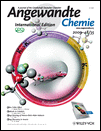Hypervalent Carbon Atom: “Freezing” the SN2 Transition State†
Simon C. A. H. Pierrefixe Dr.
Department of Theoretical Chemistry and Amsterdam Center for Multiscale Modeling, Scheikundig Laboratorium der Vrije Universiteit, De Boelelaan 1083, 1081 HV Amsterdam (The Netherlands), Fax: (+31) 20-5987-629
Search for more papers by this authorSebastiaan J. M. van Stralen
Department of Theoretical Chemistry and Amsterdam Center for Multiscale Modeling, Scheikundig Laboratorium der Vrije Universiteit, De Boelelaan 1083, 1081 HV Amsterdam (The Netherlands), Fax: (+31) 20-5987-629
Search for more papers by this authorJoost N. P. van Stralen Dr.
Department of Theoretical Chemistry and Amsterdam Center for Multiscale Modeling, Scheikundig Laboratorium der Vrije Universiteit, De Boelelaan 1083, 1081 HV Amsterdam (The Netherlands), Fax: (+31) 20-5987-629
Search for more papers by this authorCélia Fonseca Guerra Dr.
Department of Theoretical Chemistry and Amsterdam Center for Multiscale Modeling, Scheikundig Laboratorium der Vrije Universiteit, De Boelelaan 1083, 1081 HV Amsterdam (The Netherlands), Fax: (+31) 20-5987-629
Search for more papers by this authorF. Matthias Bickelhaupt Prof. Dr.
Department of Theoretical Chemistry and Amsterdam Center for Multiscale Modeling, Scheikundig Laboratorium der Vrije Universiteit, De Boelelaan 1083, 1081 HV Amsterdam (The Netherlands), Fax: (+31) 20-5987-629
Search for more papers by this authorSimon C. A. H. Pierrefixe Dr.
Department of Theoretical Chemistry and Amsterdam Center for Multiscale Modeling, Scheikundig Laboratorium der Vrije Universiteit, De Boelelaan 1083, 1081 HV Amsterdam (The Netherlands), Fax: (+31) 20-5987-629
Search for more papers by this authorSebastiaan J. M. van Stralen
Department of Theoretical Chemistry and Amsterdam Center for Multiscale Modeling, Scheikundig Laboratorium der Vrije Universiteit, De Boelelaan 1083, 1081 HV Amsterdam (The Netherlands), Fax: (+31) 20-5987-629
Search for more papers by this authorJoost N. P. van Stralen Dr.
Department of Theoretical Chemistry and Amsterdam Center for Multiscale Modeling, Scheikundig Laboratorium der Vrije Universiteit, De Boelelaan 1083, 1081 HV Amsterdam (The Netherlands), Fax: (+31) 20-5987-629
Search for more papers by this authorCélia Fonseca Guerra Dr.
Department of Theoretical Chemistry and Amsterdam Center for Multiscale Modeling, Scheikundig Laboratorium der Vrije Universiteit, De Boelelaan 1083, 1081 HV Amsterdam (The Netherlands), Fax: (+31) 20-5987-629
Search for more papers by this authorF. Matthias Bickelhaupt Prof. Dr.
Department of Theoretical Chemistry and Amsterdam Center for Multiscale Modeling, Scheikundig Laboratorium der Vrije Universiteit, De Boelelaan 1083, 1081 HV Amsterdam (The Netherlands), Fax: (+31) 20-5987-629
Search for more papers by this authorWe thank the National Research School Combination for Catalysis (NRSC-C) and the Netherlands Organization for Scientific Research (NWO-CW and NWO-NCF) for financial support.
Graphical Abstract
Supporting Information
Detailed facts of importance to specialist readers are published as ”Supporting Information”. Such documents are peer-reviewed, but not copy-edited or typeset. They are made available as submitted by the authors.
| Filename | Description |
|---|---|
| anie_200902125_sm_miscellaneous_information.pdf111 KB | miscellaneous information |
Please note: The publisher is not responsible for the content or functionality of any supporting information supplied by the authors. Any queries (other than missing content) should be directed to the corresponding author for the article.
References
- 1G. N. Lewis, J. Am. Chem. Soc. 1916, 38, 762.
- 2
- 2aK. Y. Akiba in Chemistry of Hypervalent Compounds (Ed.: ), Wiley-VCH, Weinheim, 1998, chap. 1 and 2;
- 2bC. Chuit, R. J. P. Corriu, C. Reye in Chemistry of Hypervalent Compounds (Ed.: ), Wiley-VCH, Weinheim, 1998, chap. 4.
- 3
- 3aR. Hoffmann, Solids and Surfaces: A Chemist’s View of Bonding in Extended Structures, Wiley, New York, 1989;
- 3bJ. I. Musher, Angew. Chem. 1969, 81, 68;
10.1002/ange.19690810204 Google ScholarAngew. Chem. Int. Ed. Engl. 1969, 8, 54;
- 3cL. Pauling, The Nature of the Chemical Bond, 3rd ed., Cornell University Press, Ithaca, 1960.
- 4S. C. A. H. Pierrefixe, C. Fonseca Guerra, F. M. Bickelhaupt, Chem. Eur. J. 2008, 14, 819.
- 5
- 5aW. N. Olmstead, J. I. Brauman, J. Am. Chem. Soc. 1977, 99, 4219;
- 5bL. Q. Deng, V. Branchadell, T. Ziegler, J. Am. Chem. Soc. 1994, 116, 10645;
- 5cJ. M. Gonzales, R. S. Cox, S. T. Brown, W. D. Allen, H. F. Schaefer, J. Phys. Chem. A 2001, 105, 11327;
- 5dA. P. Bento, M. Solà, F. M. Bickelhaupt, J. Comput. Chem. 2005, 26, 1497;
- 5eA. P. Bento, F. M. Bickelhaupt, J. Org. Chem. 2007, 72, 2201;
- 5fA. P. Bento, F. M. Bickelhaupt, J. Org. Chem. 2008, 73, 7290;
- 5gI. Fernandez, G. Frenking, E. Uggerud, Chem. Eur. J. 2009, 15, 2166;
- 5hE. Uggerud, Pure Appl. Chem. 2009, 81, 709.
- 6
- 6aT. R. Forbus, J. C. Martin, J. Am. Chem. Soc. 1979, 101, 5057;
- 6bJ. C. Martin, Science 1983, 221, 509;
- 6cK. Akiba, M. Yamashita, Y. Yamamoto, S. Nagase, J. Am. Chem. Soc. 1999, 121, 10644;
- 6dM. Yamashita, Y. Yamamoto, K. Y. Akiba, D. Hashizume, F. Iwasaki, N. Takagi, S. Nagase, J. Am. Chem. Soc. 2005, 127, 4354.
- 7
- 7aG. te Velde, F. M. Bickelhaupt, E. J. Baerends, C. Fonseca Guerra, S. J. A. van Gisbergen, J. G. Snijders, T. Ziegler, J. Comput. Chem. 2001, 22, 931;
- 7bwww.scm.com, and references cited therein;
- 7cY. Zhao, D. G. Truhlar, Theor. Chem. Acc. 2008, 120, 215.
- 8S. C. A. H. Pierrefixe, J. Poater, C. Im, F. M. Bickelhaupt, Chem. Eur. J. 2008, 14, 6901.
- 9See, for example: G. A. Landrum, N. Goldberg, R. Hoffmann, J. Chem. Soc. Dalton Trans. 1997, 3605.
- 10See also: E. J. Bieske, O. Dopfer, Chem. Rev. 2000, 100, 3963.
- 11F. M. Bickelhaupt, T. Ziegler, P. v. R. Schleyer, Organometallics 1996, 15, 1477.
- 12Zero-point vibrational energy (ZPE) effects were computed using the harmonic approximation. In the case of double-well potentials with low barriers, this yields an estimate of the order of magnitude of the exact ZPE effects.





